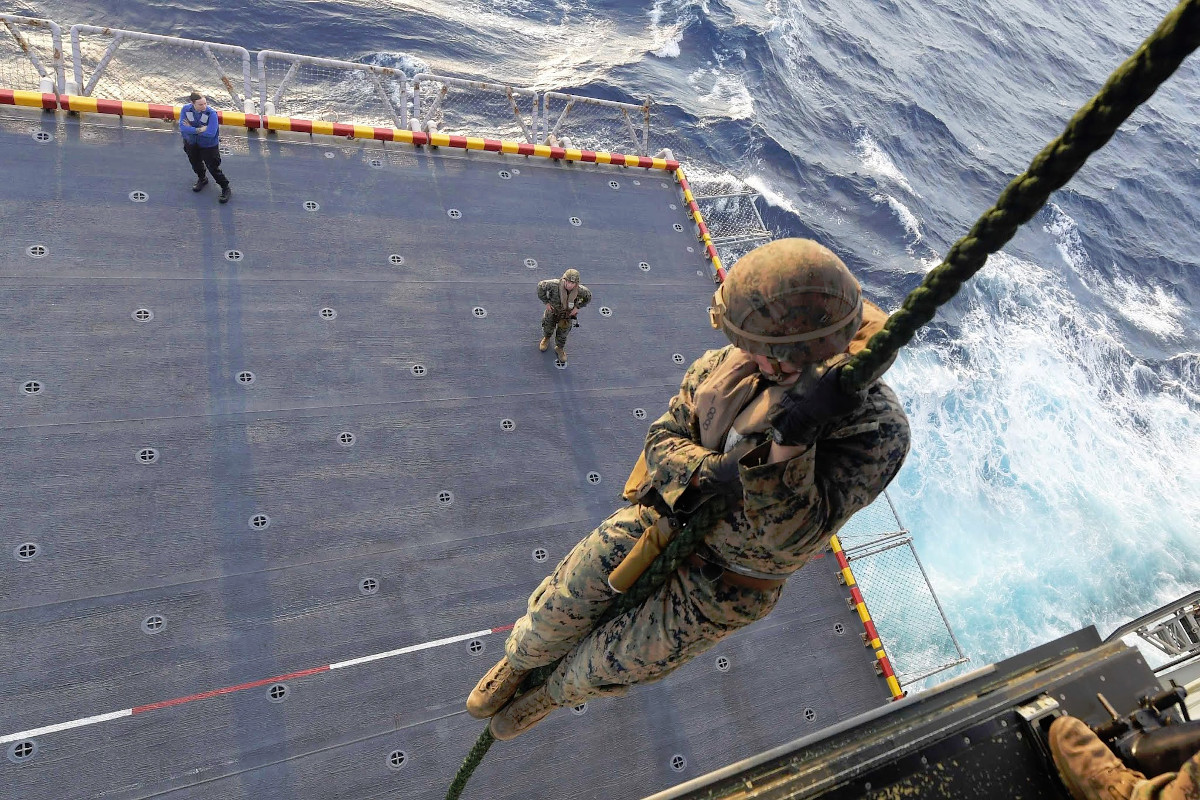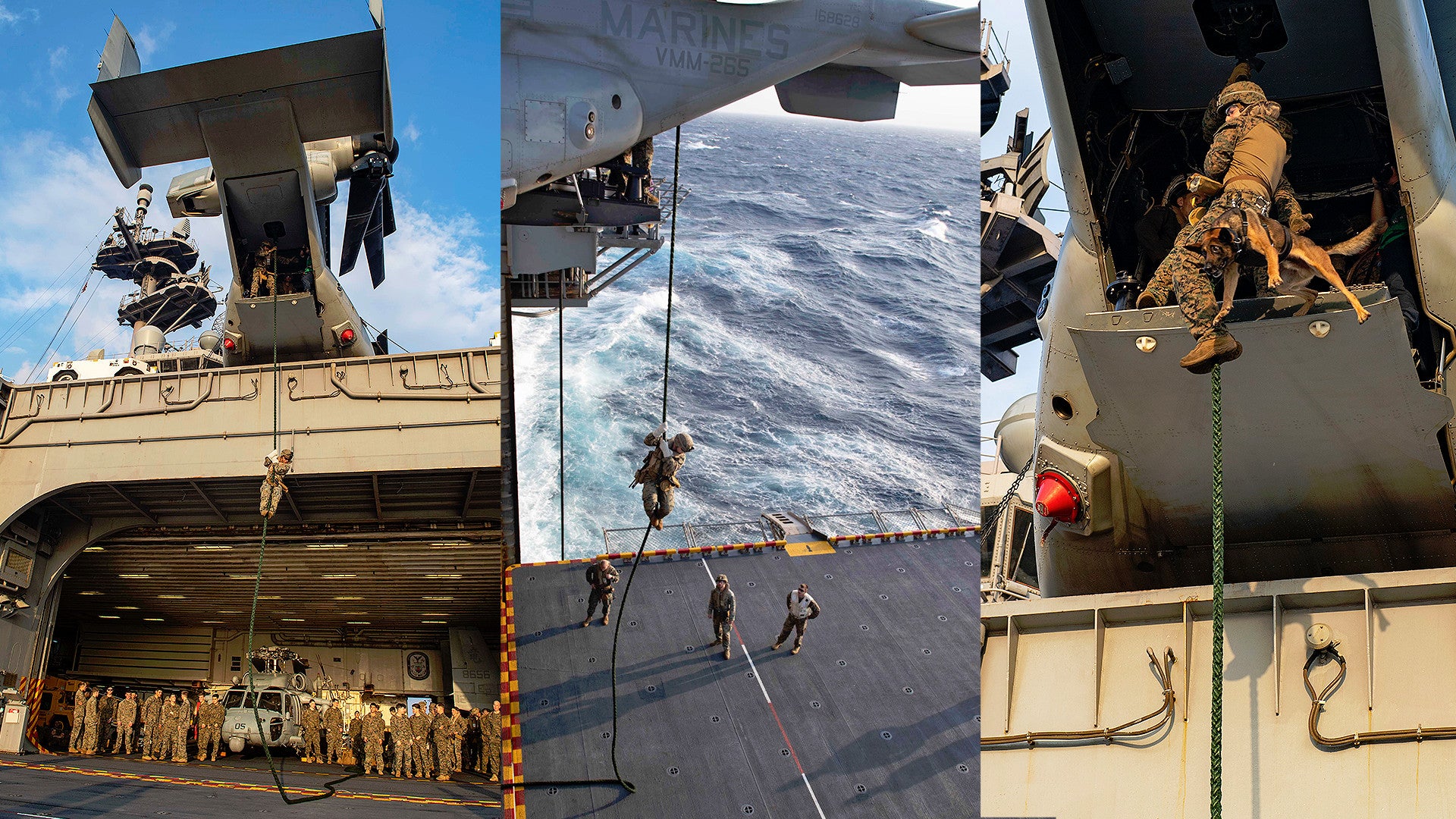U.S. Marines on board the Navy’s newest amphibious assault ship, the first-in-class USS America, recently conducted fast rope training that made good of what space they have available at sea. Personnel from the 31st Marine Expeditionary Unit (MEU) parked one of their MV-22B Osprey tilt-rotor transports with its tail end overhanging the edge of one of America‘s lowered aircraft elevators so Marines could drop down below. This particular Osprey also represents the latest Marine Corps configuration, which includes an expanded communications suite and upgraded defensive systems.
America, with the elements of the 31st MEU embarked, is presently sailing in the South China Sea. Even at sea, the Marines need to keep their skills sharp in case of any potential contingencies, which includes training to fast-rope out of the back of their Ospreys.

The concept of using a lowered aircraft elevator on an amphibious assault ship to create a well for this kind of fast-rope training is hardly new. It’s a routine practice that was already in use more than a decade ago when the Marines were still flying CH-46 Sea Knights, all of which have now been replaced by Ospreys.


Doing this makes good sense, too, for honing basic skills, since the Osprey doesn’t even need to be airborne, which saves on fuel and maintenance costs. Of course, actually fast-roping from an MV-22B hovering in mid-air is a bit more of an intense experience, so it doesn’t completely remove the need for more advanced training.
The pictures from this particular round of fast-rope training also offer a good look at an Osprey with a number of significant modifications that the Marines have been steadily adding to its MV-22 fleet in recent years. This MV-22B, which has the Bureau Number 168628 and is assigned to Marine Medium Tiltrotor Squadron 265 (VMM-265), features a new satellite communications and data sharing system and a directional infrared countermeasures (DIRCM) system.
The SATCOM system is known as NOTM-Airborne Increment II, which the Marine Corps began testing on the Osprey in November 2017. The service started fielding the system on its MV-22s in 2018. Tilt-rotors with NOTM-A Increment II installed are readily identifiable by the large dome on the top of the rear fuselage, which replaces a rear overhead hatch. The system provides robust beyond-line-of-sight connectivity to the ever more capable Ospreys.
“It can take hours to fly to a location to complete a mission, and during that time, the situation on the ground can change significantly,” said Chris Wagner, then the NOTM program’s lead engineer at Marine Corps Systems Command, said in an official interview in June 2018.
“If the situation on the ground changes, we can get updates to the Common Operating Picture, from reconnaissance assets to the commander enabling mission changes while en route,” U.S. Marine Corps Lieutenant Colonel Devin Licklider, then Marine Corps Systems Command’s Program Manager for Command and Control Systems, said in a separate interview at the time.

This particular Osprey is also equipped with a variant of the Department of the Navy Large Aircraft Infrared Countermeasures system, or DoN LAIRCM. Different configurations of this system, which Northrop Grumman produces, are in service across the U.S. military on a variety of aircraft and helicopters.
The installation on the MV-22B consists of various warning sensors positioned around the fuselage and two so-called pointer-tracker assemblies mounted on the lower side of the rear fuselage, one on each side of the tilt-rotor’s rear loading ramp. The point-trackers on Osprey from VMM-265 that Marines used for fast-rope training had red protective covers in place to shield them from the elements. The general configuration originated on the Air Force’s CV-22 special operations Ospreys and has finally made its way to the USMC’s MV-22 fleet.
The system is designed to defeat heat-seeking missiles, including shoulder-fired man-portable air defense systems, or MANPADS, which are particularly threatening to helicopters and tilt-rotors when they are landing, taking off, or hovering close to the ground. The warning sensors detect the incoming infrared-homing threats and cues one of the pointer-trackers to engage it with a laser beam. The laser blinds and confuses the missile’s seeker head, causing it to wander off course.
All told, the 31st MEU recent fast-rope training on board USS America combined a well-established technique for honing these skills while at sea with one of the Marine Corps’ most up-to-date Ospreys.
It also looks like a heck of a lot of fun!
Thanks to UK Defence Journal‘s Twitter account for bringing the pictures from this recent fast-rope training to our attention.
Contact the author: joe@thedrive.com
